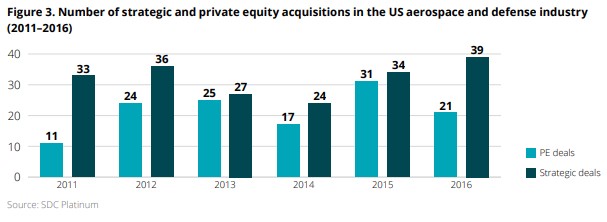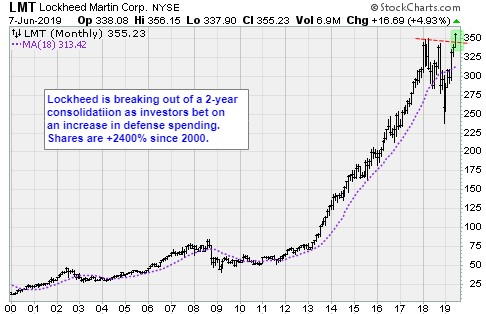Jump on a Lockheed rocket to capitalize on defense spending boost
What do tariffs, Mexico, Europe and the defense industry have in common?
President Trump tweeted Saturday that the U.S. and Mexico reached a deal to avert new tariffs. The Mexicans will send 6,000 troops to their southern border to slow migration from Central America.
The agreement bolsters the president’s case for weaponizing tariffs.
And this strategy is likely headed to Europe, to the benefit of the U.S. defense sector.
Long before the 2016 presidential election, candidate Trump promised to make the Europeans pay their fair share for North Atlantic Treaty Organization defense spending. He stepped up that rhetoric May 2017, when he met with NATO country members in Brussels.
The president’s assertion, although rough around the edges, is basically true.
NATO defense ministers set a guideline in 2006 for member countries to spend 2% of their gross domestic product on defense each year. The nonbinding marker came at a time when the U.S. was spending heavily to fund the Iraq and Afghanistan wars.
When Russia annexed Crimea in 2014, NATO leaders gave the guideline more teeth. Heads of state were required to endorse an agreement to move toward the 2% goal by 2024.
Only five of the 28 member countries meet that goal today: the U.S., Greece, Britain, Estonia and Poland.
As with Mexico and border security, the president is likely to threaten the Europeans with new tariffs to get NATO countries to step up their defense spending.
It’s a move that was foreshadowed in August 2018, when the president told supporters at a West Virginia rally that he would slap a 25% tax on every car that comes into the U.S. from the European Union.
The president believes tariffs are an effective weapon to force countries to succumb to his demands.
Managers in the aerospace and defense sector got the message long ago. They could see better times ahead and the obvious advantages of scale.
PricewaterhouseCoopers, a leading global accounting and consulting firm, found mergers and acquisitions inside the sector reached $72 billion in 2017, besting the previous high set in 2015.
And The Wall Street Journal reported Saturday, United Technologies (UTX) and Raytheon (RTN) are in merger talks. The $160 billion union would refocus the companies on aerospace.
Teaming with Raytheon would be a boon for UTX shareholders. Bringing its Pratt & Whitney jet engine business to Raytheon — a partner in the F-35 combat jet project, and a missile and avionics maker — is a natural fit with plenty of synergies.
It’s also the type of project that would ultimately benefit if the White House manages to get NATO countries to increase defense spending.
Lockheed Martin (LMT) is another way for investors to get ready.
In addition to its lead position in F-35, the Maryland company is at the vanguard of 3D printing, big data, space engineering and other technologies important to NATO allies.
As the world marvels at tiny satellites and reusable, autonomous rockets, Lockheed engineers are busy focusing beyond boosters. They want to put a satellite factory in space. And it’s not as far-fetched as it seems.
Lockheed 3D printed parts in 2016 for NASA’s Juno Jupiter orbiter. Two years later, another satellite commissioned by the U.S. Air Force was designed and built using a 3D printing technique called Laser Powder Bed Fusion.
A bed of aluminum powder is laid precisely into place by a robotic arm. A laser guided by a digital file then melts the powder to form the custom part. The process reduces production cycles, and costs.
3D printing satellites in space would negate the need for expensive rocket launches.
It’s the same ingenuity Lockheed engineers are using to tackle cybersecurity. For decades they have been collecting, analyzing and using data to catch state-sponsored hackers. In the new digital era, this skill is more in demand than ever.
Meanwhile, its defense business remains robust. The company was awarded a $1.8 billion contract by the U.S. Air Force June 7, for the development of the Lightning II, a variation of the F-35 fighter jet.
Sales shot 7.6% higher in 2018, to a record $53.7 billion. Profits ballooned 167% to $5 billion. The five-year average for return on invested capital is a staggering 31%.
Lockheed shares have been on fire this year, rising 35.7%. The strength has moved the stock to 14.3x forward earnings, and 1.7x sales. The market capitalization is now $100 billion.
While this is strong, the best is yet to come, especially if the administration continues to push NATO countries to increase defense spending.
Investors should use consider using any weakness in the months ahead to add new long-term positions. Based on sales growth and internal momentum alone, shares could trade to $460 in two years, representing a return of 30% from current levels at $356.10.
Best wishes,
Jon D. Markman





